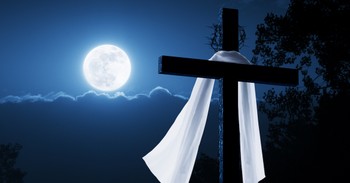
In the year 1009, al-Hakim, the Caliph of Egypt, ordered the Church of the Holy Sepulcher in Jerusalem destroyed. Workmen obeyed; and Yahia ibn Sa`id, an Islamic historian, wrote: "...the holy deed commenced on Tuesday, the fifth day before the end of the month of Safar of the year 400 of the Egira." Converting from the Muslim calendar would place the destruction on or about this day, October 17, 1009.*
The demolition of this site, so holy to Christians, began with the empty tomb where Jesus had allegedly been buried, and continued with the dome. Destruction was not total, however, because as the high parts fell, rubble blocked the workmen from getting at lower parts. For close to forty years, Christians were forbidden to visit the site.
Constantine, the first emperor to identify with Christianity, built the original Church of the Holy Sepulcher, acting on the researches of his mother Helena. When she identified the cave in which Christ was thought to have lain, her son ordered the bishop of Jerusalem to begin building. "It will be well, therefore, for your sagacity to make such arrangements and provision of all things needful for the work, that not only the church itself as a whole may surpass all others whatsoever in beauty, but that the details of the building may be of such a kind that the fairest structures in any city of the empire may be excelled by this."
In his biography of Constantine, Eusebius wrote, "This monument, therefore, first of all, as the chief part of the whole, the emperor's zealous magnificence beautified with rare columns, and profusely enriched with the most splendid decorations of every kind."
The Persians destroyed the magnificent edifice in 614, but it was partly restored--to be smashed again by the Caliph al-Hakim four hundred years later.
A treaty between Byzantium and the Muslims allowed Christians to rebuild the Church of the Holy Sepulcher about forty years after al-Hakim's "holy deed." The new structure was much more modest than the original. Crusaders later rebuilt the whole under one roof and added some other buildings, but their work fell into disrepair over the centuries and had to be renovated in the 1960s.
In recent years, the Palestine Authority has attempted to gain control of several Christian sites, including the Church of the Holy Sepulcher, as a means of bringing political pressure to bear on the governments of Christian nations.
-------
*Islamic months vary in length according to sightings of the moon. I have not been unable to ascertain whether Safar had an extra day that year. According to Tarek's universal converter, the 25th of Safar 400 would be the 17th of October in the Julian calendar which was the calendar in use in the west at that time.
Bibliography:
- "Basilica of the Anastasis/Resurrection; the great destruction and its aftermath." http://198.62.75.1/www1/jhs/TSspdest.html
- "Jerusalem. The Church of the Holy Sepulcher." http://www.israel-mfa.gov.il/mfa/go.asp?MFAH00v10
- "Tarek's Hijri/Gregorian/Julian Converter." http://bennyhills.fortunecity.com/elfman/ 454/calindex.html
- Various internet articles.
Last updated July, 2007


